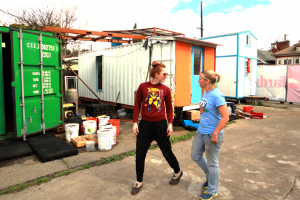One step backward, two steps forward. This is what a lot of the learning experiences on THIMBY have felt like this summer as we work to complete our innovative-yet-replicable, sustainable-yet-affordable tiny house, reconciling contradictions and tradeoffs in the green building world. One such tradeoff: how to create the best possible building envelope in materials that are high performance, lightweight, readily available, and environmentally sustainable. The answer: cork. Thermacork insulation is made from the bark of cork trees harvested in Portugal, trees that grow for over 150 years in the unique Southwestern Mediterranean ecosystem that has supported abundant biodiversity and human economic enterprise for thousands of years. The bark is stripped during the months of June and July, once every 9 years per tree, allowing the tree to regenerate in the interim while being harvested over 15 times in its lifetime. It is a 100% natural material, with the resin produced by the tree serving as an adhesive. The finished material is a carbon negative product, waste cork is used in a cork biodiesel power plant that powers the manufacturing, and the overall process is “one of the most sustainable business practices on Earth” according to the Thermacork website.
Here’s the step backward piece — we found out all this wonderful info about cork, and the fact that we could get the square footage of material we’d need donated to the project from Small Planet Supply, a Washington-based company dedicated to energy-efficient building materials and practices… after we’d already gone ahead and installed 1” rigid foam polyiso on the exterior facade, and painted it black to cover the foil and use as the backdrop for the cedar siding and battens. It was cheap, light, and readily available. The problem was, the paint kept chipping off the foil, leaving shiny imperfections that you’d see through the 1” gaps between cedar siding boards. We feared this would only get worse as we drove the whole thing down the highway to the competition and going forward in time. Wanting THIMBY to last well into the future, it seemed almost sacrilegious to mount all the reclaimed cedar we’d spent days milling to perfection on a shaky, petroleum-based product. Should we apply more layers of expensive liquid weather-proofing membranes? Or move in another direction?
Enter cork! After several phone calls with Small Planet Supply, we got the cork loaded on a truck Friday afternoon, and it arrived at the build site Monday. On Tuesday, powered by a team of friends and volunteers, all the foam insulation was removed and all the cork installed on the North and South facades, a 15 hour marathon workday. It installed easily, looks great and the cedar siding can be installed directly onto the cork, without any other layers of paint or material. Two steps forward.
The standard density cork insulation is R-4 per inch, and we consulted European product performance statements (where this product is much more commonly used) to verify that it wouldn’t degrade with exterior exposure in the 1” siding gaps. It’s tree bark, after all, naturally adapted to handle the sun, rain, and wind. Plus it’s affordable, $72 for a pack of 12 1” panels (we needed 8 packs to cover about 500 sf), only slightly more expensive than the cost of the foam insulation plus material to coat over it to make the exterior insulation ready to fasten to our wood siding. Other features of cork: it doesn’t lose thermal resistance over time, has great sound isolation, and resists compression. A true victory for the sustainable materials procurement of THIMBY!






